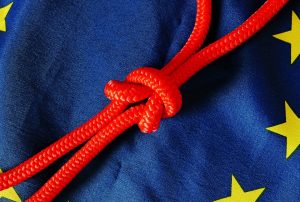
In recent years, Euroscepticism has moved towards mainstream political and popular culture, with a strength that has come as a surprise to many. Eurosceptic parties gain more traction and public support at a European, national and local level, threatening the legitimacy and popularity of the integration process.
The debate in the media focuses on Eurosceptic claims, but in such a complex landscape, building a clear understanding of the phenomenon is not easy. In order to do so, we must look at a variety of concepts and articles from academic and non-academic sources.
The basic definition (according to the OED) is:
“A person who is opposed to increasing the powers of the European Union”.
A more detailed definition is given by Michael Ray:
“European political doctrine that advocates disengagement from the European Union (EU). Political parties that espouse a Eurosceptic viewpoint tend to be broadly populist and generally support tighter immigration controls in addition to the dismantling or streamlining of the EU bureaucratic structure”.
In this article, Ray traces the historical steps by which the EU came to be. Euroscepticism seems to be relatively new, but it is not a recent phenomenon. These attitudes have always been present since the European Integration process began, following different paths in the different Member States. Ray’s analysis of how Euroscepticism took different forms in UK, France and Italy is particularly telling.
Two kind of Euroscepticism emerged: soft and hard. Taggart and Szczerbiak first conceptualised in their 2002 article, “The Party Politics of Euroscepticism in EU Member and Candidate States” (a paper prepared for presentation at the European Consortium for Political Research Joint Workshops, Turin, March 21-27, 2002).
Hard Euroscepticism was labelled as: “principled opposition to the project of European integration based on the ceding or transfer of powers to supranational institutions such as the EU”.
Fifteen years later, and following Brexit, the same authors returned to the subject, to re-examine hard Euroscepticism, in light of the fact that withdrawal from EU was now a serious political option, previously seemingly unthinkable for mainstream political actors.
They observed two responses to Brexit across European countries. In the short-term, Brexit, paradoxically, has dampened down support for Euroscepticism, but, “in the longer-term it may lead to the strengthening of the Hard version of it“.
The sources which have brought rise to Euroscepticism are of a different nature. From 2018 onwards EU has faced a number of sensitive challenges which are source of concerns and tensions among the Member States. Paul Taggart & Aleks Szczerbiak, in their article “Putting Brexit into perspective: the effect of the Eurozone and migration crises and Brexit on Euroscepticism in European States”, published on the Journal of European Public Policy in 2018, identifies four main frames in which EU is contested in European States focusing on: economic factors, immigration, national sovereignty and peculiar local features.
Eurosceptic and populist parties often overlap, but they are not necessary convergent. Although the link can be very strong, as Max Hänska, Senior Lectuer in Digital Journalism, De Montfort University and Vassilios Paipais, lecturer in International Relations, University of St Andrews in The Conversation Online Newspaper suggest happened in the last political Italian elections.
In the academic article published by Sage Journal in March 2018 by Andrea LP Pirro an Paul Taggart, a four-step model is presented to better understand the links between Euroscepticism and populism: three concepts (populism, Euroscepticism, crisis) and a dynamic process (impact) in order to determine how those critical events that punctuated European integration over the last decade, and which, in turn, has affected the Eurosceptic politics of populist parties.
The peculiar local features must be taken into account – for instance in Britain, it was that their membership of the EU was understood and evaluated in terms of cost-benefit, not in terms of emotional attachment. This can be seen, to a lesser extent, in the dynamics of Italy, France and the Netherlands.
Generally, Eurosceptic sentiment stems from two principal causes – economic and identity crises. Indeed, the EU is experiencing a lack of integration: for the most part, European Citizens see the EU as an overarching authority, strengthening its power to the detriment of the single Member States. A widespread perception is that some States are taking advantage of others. This perceived imbalanced undermines a solid foundation need for future reforms, and exacerbates resentment among Member States.
The wors case scenario that may develop if an alternative solution to engender cooperation is not found, is the increasingly rise of populist Eurosceptic parties. There may follow other EU-exit referendum, depending on the outcome of Brexit for the UK and the EU
Brexit represents an historically significant event. Numerous studies, reports and articles have been written on this phenomenon as well as mainstream media speculation and exploration.
The Independent article “Euroscepticism plummets in Denmark as consequences of Brexit become clear”, reveals Danish attitudes, which were traditionally Eurosceptic, have softened dramatically since the Brexit vote. This was illustrated by a new poll for Danish public broadcaster DR conducted by Epinion.
EAVI is especially interested in investigating the role of the media in the spread of Euroscepticism. “A spiral of Euroscepticism: The Media’s Fault” (Claes H. de Vreese Department of Communication Science, University of Amsterdamarticle, Acta Politica, 2007, 42, (271–286) 2007 Palgrave Macmillan Ltd 0001-6810/07) estimates the impact of media role in the emergence and consolidation of Euroscepticism in the public consciousness.
It is, commonly recognized that the media influences the political attitudes of citizens. Drawing on experimental data and evidence from panel surveys in two countries, this article demonstrates how news media, by framing Euro-politics as an arena for strategically operating, self-serving politicians, can fuel public cynicism and scepticism.
Euroscepticism undermines the European Union from within, and as such poses an existential threat. Of the many actions that must be taken to counter the phenomenon, at EAVI we believe that making Europe media literate must be among the key priorities should the Union survive the storms ahead.

In recent years, Euroscepticism has moved towards mainstream political and popular culture, with a strength that has come as a surprise to many. Eurosceptic parties gain more traction and public support at a European, national and local level, threatening the legitimacy and popularity of the integration process.
The debate in the media focuses on Eurosceptic claims, but in such a complex landscape, building a clear understanding of the phenomenon is not easy. In order to do so, we must look at a variety of concepts and articles from academic and non-academic sources.
The basic definition (according to the OED) is:
“A person who is opposed to increasing the powers of the European Union”.
A more detailed definition is given by Michael Ray:
“European political doctrine that advocates disengagement from the European Union (EU). Political parties that espouse a Eurosceptic viewpoint tend to be broadly populist and generally support tighter immigration controls in addition to the dismantling or streamlining of the EU bureaucratic structure”.
In this article, Ray traces the historical steps by which the EU came to be. Euroscepticism seems to be relatively new, but it is not a recent phenomenon. These attitudes have always been present since the European Integration process began, following different paths in the different Member States. Ray’s analysis of how Euroscepticism took different forms in UK, France and Italy is particularly telling.
Two kind of Euroscepticism emerged: soft and hard. Taggart and Szczerbiak first conceptualised in their 2002 article, “The Party Politics of Euroscepticism in EU Member and Candidate States” (a paper prepared for presentation at the European Consortium for Political Research Joint Workshops, Turin, March 21-27, 2002).
Hard Euroscepticism was labelled as: “principled opposition to the project of European integration based on the ceding or transfer of powers to supranational institutions such as the EU”.
Fifteen years later, and following Brexit, the same authors returned to the subject, to re-examine hard Euroscepticism, in light of the fact that withdrawal from EU was now a serious political option, previously seemingly unthinkable for mainstream political actors.
They observed two responses to Brexit across European countries. In the short-term, Brexit, paradoxically, has dampened down support for Euroscepticism, but, “in the longer-term it may lead to the strengthening of the Hard version of it“.
The sources which have brought rise to Euroscepticism are of a different nature. From 2018 onwards EU has faced a number of sensitive challenges which are source of concerns and tensions among the Member States. Paul Taggart & Aleks Szczerbiak, in their article “Putting Brexit into perspective: the effect of the Eurozone and migration crises and Brexit on Euroscepticism in European States”, published on the Journal of European Public Policy in 2018, identifies four main frames in which EU is contested in European States focusing on: economic factors, immigration, national sovereignty and peculiar local features.
Eurosceptic and populist parties often overlap, but they are not necessary convergent. Although the link can be very strong, as Max Hänska, Senior Lectuer in Digital Journalism, De Montfort University and Vassilios Paipais, lecturer in International Relations, University of St Andrews in The Conversation Online Newspaper suggest happened in the last political Italian elections.
In the academic article published by Sage Journal in March 2018 by Andrea LP Pirro an Paul Taggart, a four-step model is presented to better understand the links between Euroscepticism and populism: three concepts (populism, Euroscepticism, crisis) and a dynamic process (impact) in order to determine how those critical events that punctuated European integration over the last decade, and which, in turn, has affected the Eurosceptic politics of populist parties.
The peculiar local features must be taken into account – for instance in Britain, it was that their membership of the EU was understood and evaluated in terms of cost-benefit, not in terms of emotional attachment. This can be seen, to a lesser extent, in the dynamics of Italy, France and the Netherlands.
Generally, Eurosceptic sentiment stems from two principal causes – economic and identity crises. Indeed, the EU is experiencing a lack of integration: for the most part, European Citizens see the EU as an overarching authority, strengthening its power to the detriment of the single Member States. A widespread perception is that some States are taking advantage of others. This perceived imbalanced undermines a solid foundation need for future reforms, and exacerbates resentment among Member States.
The wors case scenario that may develop if an alternative solution to engender cooperation is not found, is the increasingly rise of populist Eurosceptic parties. There may follow other EU-exit referendum, depending on the outcome of Brexit for the UK and the EU
Brexit represents an historically significant event. Numerous studies, reports and articles have been written on this phenomenon as well as mainstream media speculation and exploration.
The Independent article “Euroscepticism plummets in Denmark as consequences of Brexit become clear”, reveals Danish attitudes, which were traditionally Eurosceptic, have softened dramatically since the Brexit vote. This was illustrated by a new poll for Danish public broadcaster DR conducted by Epinion.
EAVI is especially interested in investigating the role of the media in the spread of Euroscepticism. “A spiral of Euroscepticism: The Media’s Fault” (Claes H. de Vreese Department of Communication Science, University of Amsterdamarticle, Acta Politica, 2007, 42, (271–286) 2007 Palgrave Macmillan Ltd 0001-6810/07) estimates the impact of media role in the emergence and consolidation of Euroscepticism in the public consciousness.
It is, commonly recognized that the media influences the political attitudes of citizens. Drawing on experimental data and evidence from panel surveys in two countries, this article demonstrates how news media, by framing Euro-politics as an arena for strategically operating, self-serving politicians, can fuel public cynicism and scepticism.
Euroscepticism undermines the European Union from within, and as such poses an existential threat. Of the many actions that must be taken to counter the phenomenon, at EAVI we believe that making Europe media literate must be among the key priorities should the Union survive the storms ahead.

In recent years, Euroscepticism has moved towards mainstream political and popular culture, with a strength that has come as a surprise to many. Eurosceptic parties gain more traction and public support at a European, national and local level, threatening the legitimacy and popularity of the integration process.
The debate in the media focuses on Eurosceptic claims, but in such a complex landscape, building a clear understanding of the phenomenon is not easy. In order to do so, we must look at a variety of concepts and articles from academic and non-academic sources.
The basic definition (according to the OED) is:
“A person who is opposed to increasing the powers of the European Union”.
A more detailed definition is given by Michael Ray:
“European political doctrine that advocates disengagement from the European Union (EU). Political parties that espouse a Eurosceptic viewpoint tend to be broadly populist and generally support tighter immigration controls in addition to the dismantling or streamlining of the EU bureaucratic structure”.
In this article, Ray traces the historical steps by which the EU came to be. Euroscepticism seems to be relatively new, but it is not a recent phenomenon. These attitudes have always been present since the European Integration process began, following different paths in the different Member States. Ray’s analysis of how Euroscepticism took different forms in UK, France and Italy is particularly telling.
Two kind of Euroscepticism emerged: soft and hard. Taggart and Szczerbiak first conceptualised in their 2002 article, “The Party Politics of Euroscepticism in EU Member and Candidate States” (a paper prepared for presentation at the European Consortium for Political Research Joint Workshops, Turin, March 21-27, 2002).
Hard Euroscepticism was labelled as: “principled opposition to the project of European integration based on the ceding or transfer of powers to supranational institutions such as the EU”.
Fifteen years later, and following Brexit, the same authors returned to the subject, to re-examine hard Euroscepticism, in light of the fact that withdrawal from EU was now a serious political option, previously seemingly unthinkable for mainstream political actors.
They observed two responses to Brexit across European countries. In the short-term, Brexit, paradoxically, has dampened down support for Euroscepticism, but, “in the longer-term it may lead to the strengthening of the Hard version of it“.
The sources which have brought rise to Euroscepticism are of a different nature. From 2018 onwards EU has faced a number of sensitive challenges which are source of concerns and tensions among the Member States. Paul Taggart & Aleks Szczerbiak, in their article “Putting Brexit into perspective: the effect of the Eurozone and migration crises and Brexit on Euroscepticism in European States”, published on the Journal of European Public Policy in 2018, identifies four main frames in which EU is contested in European States focusing on: economic factors, immigration, national sovereignty and peculiar local features.
Eurosceptic and populist parties often overlap, but they are not necessary convergent. Although the link can be very strong, as Max Hänska, Senior Lectuer in Digital Journalism, De Montfort University and Vassilios Paipais, lecturer in International Relations, University of St Andrews in The Conversation Online Newspaper suggest happened in the last political Italian elections.
In the academic article published by Sage Journal in March 2018 by Andrea LP Pirro an Paul Taggart, a four-step model is presented to better understand the links between Euroscepticism and populism: three concepts (populism, Euroscepticism, crisis) and a dynamic process (impact) in order to determine how those critical events that punctuated European integration over the last decade, and which, in turn, has affected the Eurosceptic politics of populist parties.
The peculiar local features must be taken into account – for instance in Britain, it was that their membership of the EU was understood and evaluated in terms of cost-benefit, not in terms of emotional attachment. This can be seen, to a lesser extent, in the dynamics of Italy, France and the Netherlands.
Generally, Eurosceptic sentiment stems from two principal causes – economic and identity crises. Indeed, the EU is experiencing a lack of integration: for the most part, European Citizens see the EU as an overarching authority, strengthening its power to the detriment of the single Member States. A widespread perception is that some States are taking advantage of others. This perceived imbalanced undermines a solid foundation need for future reforms, and exacerbates resentment among Member States.
The wors case scenario that may develop if an alternative solution to engender cooperation is not found, is the increasingly rise of populist Eurosceptic parties. There may follow other EU-exit referendum, depending on the outcome of Brexit for the UK and the EU
Brexit represents an historically significant event. Numerous studies, reports and articles have been written on this phenomenon as well as mainstream media speculation and exploration.
The Independent article “Euroscepticism plummets in Denmark as consequences of Brexit become clear”, reveals Danish attitudes, which were traditionally Eurosceptic, have softened dramatically since the Brexit vote. This was illustrated by a new poll for Danish public broadcaster DR conducted by Epinion.
EAVI is especially interested in investigating the role of the media in the spread of Euroscepticism. “A spiral of Euroscepticism: The Media’s Fault” (Claes H. de Vreese Department of Communication Science, University of Amsterdamarticle, Acta Politica, 2007, 42, (271–286) 2007 Palgrave Macmillan Ltd 0001-6810/07) estimates the impact of media role in the emergence and consolidation of Euroscepticism in the public consciousness.
It is, commonly recognized that the media influences the political attitudes of citizens. Drawing on experimental data and evidence from panel surveys in two countries, this article demonstrates how news media, by framing Euro-politics as an arena for strategically operating, self-serving politicians, can fuel public cynicism and scepticism.
Euroscepticism undermines the European Union from within, and as such poses an existential threat. Of the many actions that must be taken to counter the phenomenon, at EAVI we believe that making Europe media literate must be among the key priorities should the Union survive the storms ahead.








































































































































































